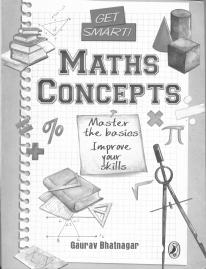This book is aimed at teaching Mathematical concepts to middle school children in an interactive and fun way. Or as the author puts it, this book would help you ‘think about mathematics’ and ‘learn to think about mathematics’. The author recommends the book to be used along with traditional text-books so as to maximize learning. Middle school-level concepts such as fractions, GCD and LCM, algebra and geometry have been dealt with in detail. While studying Maths or for that matter any subject in school, we are trained to put information in separate drawers with name tags attached (‘Chemistry’, ‘Biology, ‘Maths’ etc.). And when required, we try to find answers by opening one drawer at a time. But, as is invariably true, most information/knowledge is interrelated, and the full meaning doesn’t show itself unless you have a multidisciplinary approach, or in other words, have the ability to use information in multiple drawers at the same time. This book tries to address this issue.
The author explains: ‘Most of the mathematics in high school is interrelated, but we find it tough to draw the connections when studying the subject for the first time.’ And he goes on to state that the book is designed/presented in a way that ‘concepts are covered together with related concepts’ (for example, GCD and LCM are covered in the context of simplifying fractions).
There are various tools and insets that are used throughout the book to try and make it accessible and the learning more enjoyable. Some examples of such tools are: Get Smart Funda (Every natural number has a successor), Math Guru Speak (God created everything by number, weight and measure—Sir Isaac Newton), Very Punny (Mom: Keep your room clean. This room is not a trashcan. Son: No mom, but it is congruent to one!).
In spite of all these little distractions, the book is heavy on text for a subject like Maths. As you flip through, you see that the pages are filled with text and equations and low on diagrams or illustrations (unless illustrations of triangles, rectangles and squares excite you). The author, in the last chapter, lists top strategies for learning Math, in which strategy # 6 is ‘Make Pictures’. Wish the author had followed his own advice! In fact, there are more illustrations involving Mathematics in The Curious Incident of the Dog in the Night-Time (by Mark Haddon), a children’s novel, which has a wonder-fully accessible description of the Big-Bang theory and has Mathematics woven into its fabric (for instance, the chapters are numbered with prime numbers). Children are more likely to develop a taste for Mathematics and pick up concepts by reading such literature rather than text-heavy books that are not too different from a typical text book.
Often, before buying a dictionary, people test it by looking up their favorite/fail-safe word in it—if the dictionary has it, they’ll buy it. Same way, if you want to buy a Math book, look up how the concept of‘ð(pi)’ is explained in the book. One can make the concept as interesting or accessible as one wants, or as boring and complicated. I read the sections explaining“ð(pi)” in this book—and got nothing new or exciting out of it. Who can use this book? If your child is struggling with Maths and you are looking for a way to incite his/her latent Math-interest, this book does not fit the bill. S/he is likely to find it drab. However, if your child is super-interested in Maths and has an insatiable hunger for the subject, then this book might provide some additional fodder.

